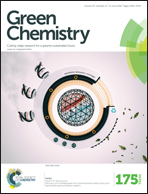Intrinsically flexible electronic materials for smart device applications†
Abstract
A novel method to fabricate chemically linked conducting polymer–biopolymer composites that are intrinsically flexible and conducting for functional electrode applications is presented. Polypyrrole was synthesised in situ during the cellulose regeneration process using the 1-butyl-3-methylimidazolium chloride ionic liquid as a solvent medium. The obtained polypyrrole–cellulose composite was chemically blended and showed flexible polymer properties while retaining the electronic properties of a conducting polymer. Addition of an ionic liquid such as trihexyl(tetradecyl)phosphonium bis(trifluoromethylsulfonyl)imide, enhanced the flexibility of the composite. The functional application of these materials in the electrochemically controlled release of a model drug has been demonstrated. This strategy opens up a new design for a wide spectrum of materials for smart electronic device applications wherein the functionality of doping and de-doping of conducting polymers is retained and their processability issue is addressed by exploiting an ionic liquid route.


 Please wait while we load your content...
Please wait while we load your content...